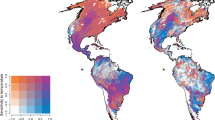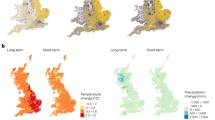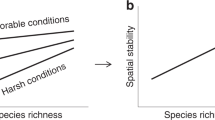Abstract
More than 500 controlled experiments have collectively suggested that biodiversity loss reduces ecosystem productivity and stability1,2,3. Yet the importance of biodiversity in sustaining the world’s ecosystems remains controversial4,5,6,7,8, largely because of the lack of validation in nature, where strong abiotic forcing and complex interactions are assumed to swamp biodiversity effects6,7,8,9. Here we test this assumption by analysing 133 estimates reported in 67 field studies that statistically separated the effects of biodiversity on biomass production from those of abiotic forcing. Contrary to the prevailing opinion of the previous two decades that biodiversity would have rare or weak effects in nature, we show that biomass production increases with species richness in a wide range of wild taxa and ecosystems. In fact, after controlling for environmental covariates, increases in biomass with biodiversity are stronger in nature than has previously been documented in experiments and comparable to or stronger than the effects of other well-known drivers of productivity, including climate and nutrient availability. These results are consistent with the collective experimental evidence that species richness increases community biomass production, and suggest that the role of biodiversity in maintaining productive ecosystems should figure prominently in global change science and policy.
This is a preview of subscription content, access via your institution
Access options
Access Nature and 54 other Nature Portfolio journals
Get Nature+, our best-value online-access subscription
$29.99 / 30 days
cancel any time
Subscribe to this journal
Receive 51 print issues and online access
$199.00 per year
only $3.90 per issue
Buy this article
- Purchase on Springer Link
- Instant access to full article PDF
Prices may be subject to local taxes which are calculated during checkout




Similar content being viewed by others
References
Loreau, M. et al. Biodiversity and ecosystem functioning: current knowledge and future challenges. Science 294, 804–808 (2001)
Hooper, D. U. et al. Effects of biodiversity on ecosystem functioning: a consensus of current knowledge. Ecol. Monogr. 75, 3–35 (2005)
Cardinale, B. J. et al. Biodiversity loss and its impact on humanity. Nature 486, 59–67 (2012)
Aarssen, L. W. High productivity in grassland ecosystems: effected by species diversity or productive species? Oikos 80, 183–184 (1997)
Huston, M. A. Hidden treatments in ecological experiments: re-evaluating the ecosystem function of biodiversity. Oecologia 110, 449–460 (1997)
Wardle, D. A. et al. Biodiversity and ecosystem function: an issue in ecology. Bull. Ecol. Soc. Am. 81, 235–239 (2000)
Srivastava, D. S. & Vellend, M. Biodiversity–ecosystem function research: is it relevant to conservation? Annu. Rev. Ecol. Evol. Syst. 36, 267–294 (2005)
Wardle, D. A. Do experiments exploring plant diversity–ecosystem functioning relationships inform how biodiversity loss impacts natural ecosystems? J. Veg. Sci. 27, 646–653 (2016)
Lepš, J. What do the biodiversity experiments tell us about consequences of plant species loss in the real world? Basic Appl. Ecol. 5, 529–534 (2004)
Schultze, E. D. & Mooney, H. A. Biodiversity and Ecosystem Function (Springer, 1994)
Hector, A. & Bagchi, R. Biodiversity and ecosystem multifunctionality. Nature 448, 188–190 (2007)
Schmid, B. et al. in Biodiversity and Ecosystem Functioning: Synthesis and Perspectives (eds Loreau, M., Naeem, S. & Inchausti, P. ) 61–75 (Oxford Univ. Press, 2002)
Loreau, M. & Hector, A. Partitioning selection and complementarity in biodiversity experiments. Nature 412, 72–76 (2001)
Maestre, F. T. et al. Plant species richness and ecosystem multifunctionality in global drylands. Science 335, 214–218 (2012)
Liang, J. et al. Positive biodiversity–productivity relationship predominant in global forests. Science 354, aaf8957 (2016)
Duffy, J. E. et al. Biodiversity mediates top-down control in eelgrass ecosystems: a global comparative-experimental approach. Ecol. Lett. 18, 696–705 (2015)
Grace, J. B. et al. Integrative modelling reveals mechanisms linking productivity and plant species richness. Nature 529, 390–393 (2016)
Zimmerman, E. K. & Cardinale, B. J. Is the relationship between algal diversity and biomass in North American lakes consistent with biodiversity experiments? Oikos 123, 267–278 (2014)
Zhang, Y., Chen, H. Y. H. & Reich, P. B. Forest productivity increases with evenness, species richness and trait variation: a global meta-analysis. J. Ecol. 100, 742–749 (2012)
Hooper, D. U. et al. A global synthesis reveals biodiversity loss as a major driver of ecosystem change. Nature 486, 105–108 (2012)
Paquette, A. & Messier, C. The effect of biodiversity on tree productivity: from temperate to boreal forests. Glob. Ecol. Biogeogr. 20, 170–180 (2011)
Duffy, J. E., Lefcheck, J. S., Stuart-Smith, R. D., Navarrete, S. A. & Edgar, G. J. Biodiversity enhances reef fish biomass and resistance to climate change. Proc. Natl Acad. Sci. USA 113, 6230–6235 (2016)
Rockström, J. et al. A safe operating space for humanity. Nature 461, 472–475 (2009)
Estes, J. A. et al. Trophic downgrading of planet Earth. Science 333, 301–306 (2011)
Danovaro, R. et al. Exponential decline of deep-sea ecosystem functioning linked to benthic biodiversity loss. Curr. Biol. 18, 1–8 (2008)
García-Comas, C . et al. Prey size diversity hinders biomass trophic transfer and predator size diversity promotes it in planktonic communities. Proc. R. Soc. B 283, 20152129 (2016)
Mora, C. et al. Global human footprint on the linkage between biodiversity and ecosystem functioning in reef fishes. PLoS Biol. 9, e1000606 (2011)
Thompson, P. L., Davies, T. J. & Gonzalez, A. Ecosystem functions across trophic levels are linked to functional and phylogenetic diversity. PLoS ONE 10, e0117595 (2015)
Ptacnik, R. et al. Diversity predicts stability and resource use efficiency in natural phytoplankton communities. Proc. Natl Acad. Sci. USA 105, 5134–5138 (2008)
Gamfeldt, L. et al. Higher levels of multiple ecosystem services are found in forests with more tree species. Nat. Commun. 4, 1340 (2013)
Ruiz-Benito, P. et al. Diversity increases carbon storage and tree productivity in Spanish forests. Glob. Ecol. Biogeogr. 23, 311–322 (2014)
Vilà, M., Vayreda, J., Gracia, C. & Ibáñez, J. J. Does tree diversity increase wood production in pine forests? Oecologia 135, 299–303 (2003)
Vilà, M. et al. Disentangling biodiversity and climatic determinants of wood production. PLoS ONE 8, e53530 (2013)
Watson, J. V. et al. Large-scale forest inventories of the United States and China reveal positive effects of biodiversity on productivity. For. Ecosyst. 2, 22 (2015)
van der Plas, F. et al. Biotic homogenization can decrease landscape-scale forest multifunctionality. Proc. Natl Acad. Sci. USA 113, 3557–3562 (2016)
Tylianakis, J. M. et al. Resource heterogeneity moderates the biodiversity–function relationship in real world ecosystems. PLoS Biol. 6, e122 (2008)
Poorter, L. et al. Diversity enhances carbon storage in tropical forests. Glob. Ecol. Biogeogr. 24, 1314–1328 (2015)
Jing, X. et al. The links between ecosystem multifunctionality and above- and belowground biodiversity are mediated by climate. Nat. Commun. 6, 8159 (2015)
Wu, J., Wurst, S. & Zhang, X. Plant functional trait diversity regulates the nonlinear response of productivity to regional climate change in Tibetan alpine grasslands. Sci. Rep. 6, 35649 (2016)
Gaitán, J. J. et al. Vegetation structure is as important as climate for explaining ecosystem function across Patagonian rangelands. J. Ecol. 102, 1419–1428 (2014)
Grace, J. B. et al. Does species diversity limit productivity in natural grassland communities? Ecol. Lett. 10, 680–689 (2007)
Acknowledgements
We thank the authors of the original studies summarized here, which are cited in Fig. 1; without these papers this study would not have been possible. J.E.D. was supported by the US National Science Foundation (OCE-1336206) and the Smithsonian Institution. B.J.C. was supported by grants from the University of Michigan’s Energy Institute and the US National Science Foundation’s DIMENSIONS of Biodiversity program (DEB-1046121). S. Brandl contributed the artwork for Fig. 3. This is contribution number 17 from the Smithsonian’s MarineGEO Network.
Author information
Authors and Affiliations
Contributions
J.E.D. conceived the idea, developed it with B.J.C., and drafted the paper with conceptual and editorial input from all authors. All authors collated the data and contributed to the analyses. C.M.G. drafted the figures.
Corresponding author
Ethics declarations
Competing interests
The authors declare no competing financial interests.
Additional information
Reviewer Information Nature thanks A. Hector, M. Loreau, P. Morin and the other anonymous reviewer(s) for their contribution to the peer review of this work.
Publisher's note: Springer Nature remains neutral with regard to jurisdictional claims in published maps and institutional affiliations.
Extended data figures and tables
Extended Data Figure 1 Comparison of diversity effect sizes on biomass production in observational versus experimental studies, using directly comparable analyses.
Symbols show mean effect sizes as β in the power function y = axβ where x is species richness (SR) and y is biomass or production. Horizontal bands denote the standard error of the parameter estimate.
Extended Data Figure 2 Schematic diagram explaining how log-response ratios (LRR) were calculated for experimental (red) and observational studies (blue).
The top diagram illustrates the calculation for a single experiment; these calculations were then repeated for multiple experiments and summarized in Fig. 3. The bottom diagram illustrates the calculation for a single observational study. Horizontal bands denote the standard error of the mean log response ratio.
Supplementary information
Supplementary Information
This file contains Supplementary Text, Supplementary Figures 1-3 and Supplementary Methods. (PDF 263 kb)
Supplementary Data
This file contains Supplementary Table 1. (XLSX 467 kb)
Rights and permissions
About this article
Cite this article
Duffy, J., Godwin, C. & Cardinale, B. Biodiversity effects in the wild are common and as strong as key drivers of productivity. Nature 549, 261–264 (2017). https://doi.org/10.1038/nature23886
Received:
Accepted:
Published:
Issue Date:
DOI: https://doi.org/10.1038/nature23886
This article is cited by
-
Towards (better) fluvial meta-ecosystem ecology: a research perspective
npj Biodiversity (2024)
-
The chytrid insurance hypothesis: integrating parasitic chytrids into a biodiversity–ecosystem functioning framework for phytoplankton–zooplankton population dynamics
Oecologia (2024)
-
Plant diversity increases spatial stability of aboveground productivity in alpine grasslands
Oecologia (2024)
-
Key questions for understanding drivers of biodiversity-ecosystem service relationships across spatial scales
Landscape Ecology (2024)
-
Non-linear effects of non-host diversity on the removal of free-living infective stages of parasites
Oecologia (2024)
Comments
By submitting a comment you agree to abide by our Terms and Community Guidelines. If you find something abusive or that does not comply with our terms or guidelines please flag it as inappropriate.



